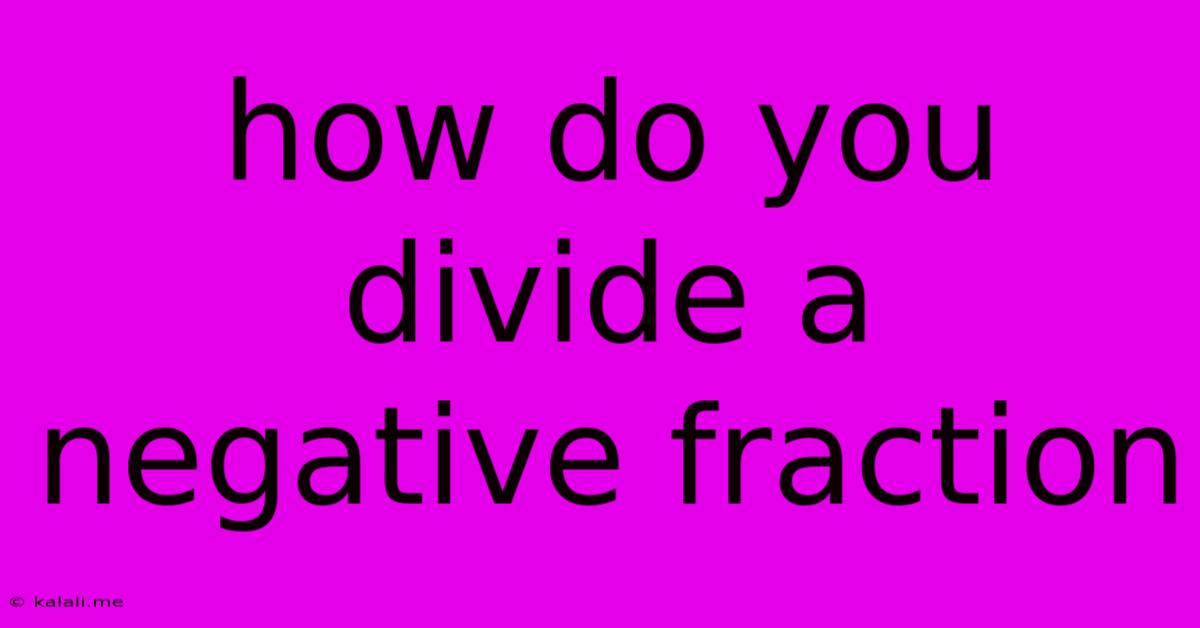How Do You Divide A Negative Fraction
Kalali
May 10, 2025 · 3 min read

Table of Contents
How to Divide a Negative Fraction: A Step-by-Step Guide
Dividing negative fractions might seem daunting, but it's a straightforward process once you understand the underlying principles. This guide will walk you through the steps, explaining the concepts clearly and providing examples to solidify your understanding. This article covers dividing negative fractions, including dealing with mixed numbers and simplifying the results. We'll also explore some common pitfalls and offer tips to avoid them.
Understanding the Basics: Reciprocals and Multiplication
The key to dividing fractions, whether positive or negative, lies in understanding reciprocals. The reciprocal of a fraction is simply flipping the numerator and the denominator. For example, the reciprocal of 2/3 is 3/2. Dividing by a fraction is the same as multiplying by its reciprocal. This holds true even when dealing with negative numbers. The sign of the result will depend on the signs of the original fractions.
Step-by-Step Guide to Dividing Negative Fractions
Here's a step-by-step method for accurately dividing negative fractions:
-
Find the reciprocal of the second fraction (the divisor): This involves switching the numerator and denominator. Remember to keep track of the negative sign. If the divisor is -3/4, its reciprocal is -4/3.
-
Change the division operation to multiplication: Dividing by a fraction is equivalent to multiplying by its reciprocal. So, instead of dividing, you'll now be multiplying.
-
Multiply the numerators and multiply the denominators: Multiply the numerators of both fractions together, and multiply the denominators together separately.
-
Determine the sign of the result: Remember the rules of multiplication with negative numbers:
- A negative number multiplied by a positive number equals a negative number.
- A negative number multiplied by a negative number equals a positive number.
-
Simplify the resulting fraction: Reduce the fraction to its simplest form by finding the greatest common divisor (GCD) of the numerator and denominator and dividing both by the GCD.
Examples
Let's illustrate this with a few examples:
Example 1: (-1/2) ÷ (1/4)
- Reciprocal of 1/4 is 4/1.
- Change to multiplication: (-1/2) x (4/1)
- Multiply numerators and denominators: (-4/2)
- Simplify: -2
Example 2: (-2/3) ÷ (-5/6)
- Reciprocal of -5/6 is -6/5.
- Change to multiplication: (-2/3) x (-6/5)
- Multiply numerators and denominators: (12/15)
- Simplify: 4/5
Example 3 (with mixed numbers): (-1 1/2) ÷ (2/3)
- Convert mixed number to improper fraction: -1 1/2 = -3/2
- Reciprocal of 2/3 is 3/2.
- Change to multiplication: (-3/2) x (3/2)
- Multiply numerators and denominators: (-9/4)
- Simplify: -2 1/4
Common Mistakes to Avoid
- Forgetting to find the reciprocal: Remember, you're multiplying by the reciprocal of the second fraction, not the fraction itself.
- Incorrectly handling negative signs: Pay close attention to the rules of multiplying and dividing with negative numbers. Double-check your work!
- Not simplifying the final answer: Always simplify your fraction to its lowest terms.
By following these steps and paying attention to the details, you can confidently divide negative fractions and achieve accurate results. Remember practice makes perfect! Try working through several examples to solidify your understanding.
Latest Posts
Latest Posts
-
24 Is 25 Of What Number
May 10, 2025
-
Cuanto Es 4 Onzas En Gramos
May 10, 2025
-
How Many Oz In Two Pounds
May 10, 2025
-
How Many Cups Is 33 8 Fl Oz Of Water
May 10, 2025
-
What Is 1 In Decimal Form
May 10, 2025
Related Post
Thank you for visiting our website which covers about How Do You Divide A Negative Fraction . We hope the information provided has been useful to you. Feel free to contact us if you have any questions or need further assistance. See you next time and don't miss to bookmark.